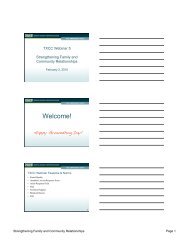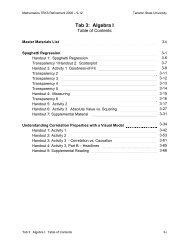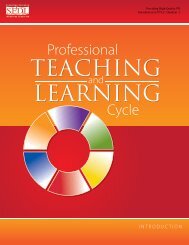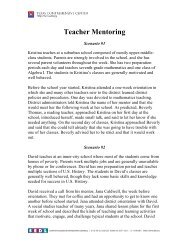Supporting Student Transition From Middle to High School - Texas ...
Supporting Student Transition From Middle to High School - Texas ...
Supporting Student Transition From Middle to High School - Texas ...
Create successful ePaper yourself
Turn your PDF publications into a flip-book with our unique Google optimized e-Paper software.
<strong>Supporting</strong> <strong>Student</strong> <strong>Transition</strong> <strong>From</strong><br />
<strong>Middle</strong> <strong>to</strong> <strong>High</strong> <strong>School</strong><br />
Introduction<br />
Jay Hertzog and Lena Morgan titled their 1999 publication<br />
<strong>Transition</strong>: A Process Not an Event. This sentiment is echoed by<br />
Nancy Mizelle (2005), who stated that transition <strong>to</strong> high school<br />
“is an extended process that involves middle and high school<br />
administra<strong>to</strong>rs, teachers, parents, and students.” In addition <strong>to</strong><br />
fac<strong>to</strong>rs such as a larger environment, increased academic demands,<br />
and reduced personal support (Smith, 2007), students also face<br />
social challenges—both real and perceived—as they move <strong>to</strong><br />
high school, including harassment or teasing by older students,<br />
reestablishing popularity, and difficulty in making new friends<br />
(Mizelle, 2005; Langenkamp, 2009). Fac<strong>to</strong>r in that many students are<br />
academically unprepared for high school, especially in large urban<br />
districts (Horwitz, 2008; Neild, 2009), and it is easy <strong>to</strong> see why the<br />
transition process is challenging for many students.<br />
Williams and Richman (2007) speak for many researchers when<br />
they state that more students fail ninth grade than any other grade,<br />
resulting in a “ninth grade bulge.” They also cite research indicating<br />
that the drop-out rate for ninth graders in urban, high-poverty<br />
4700 Mueller Blvd. Austin, TX 78723 | 800-476-6861 | www.sedl.org | txcc.sedl.org<br />
Brieng Paper<br />
QUESTION:<br />
What strategies can be implemented <strong>to</strong> aid<br />
students and their parents in the transition<br />
from eighth grade in<strong>to</strong> high school?<br />
Summary<br />
The transition from eighth grade <strong>to</strong> high school results<br />
in a higher drop-out rate and more grade retentions<br />
than any other grade. However, when districts and<br />
schools develop and implement a sound transition<br />
program, the outcomes for ninth graders are improved.<br />
Key Points<br />
• Organize a transition team<br />
• Develop a counseling team.<br />
• Create special programs and initiatives <strong>to</strong> prepare students<br />
and their families for the transition <strong>to</strong> high school.<br />
schools is as high as 40%. On a more positive note, researchers (Smith, 1997; Morgan & Hertzog, 1998) have reported dramatic<br />
lowering of the drop-out rate and ninth-grade retention in schools implementing programs using multiple transition strategies.<br />
Dedmond (2006) and Mizelle (2005) are among researchers who stress that successful transition programs are varied and multidimensional.<br />
Although little empirical research exists on the transition <strong>to</strong> high school or on the effectiveness of strategies implemented <strong>to</strong><br />
ease the transition, there have been many reports of promising practices. (Appendix B is a bibliography on high school transition<br />
and it contains reports discussing numerous suggested strategies.) A recurring theme in the reports is the use of a data, not only<br />
<strong>to</strong> track students who are at risk of leaving school or being retained but also <strong>to</strong> evaluate the effectiveness of the practices being<br />
implemented (Comprehensive <strong>School</strong> Reform Quality Center, 2005; Hammond, Lin<strong>to</strong>n, Smink, & Drew, 2007; Heppen & Therriault,<br />
2008; Morgan & Hertzog, 2001; Smith, 2006).<br />
For several years, the state of <strong>Texas</strong> has focused attention on keeping students in school and promoting college and career<br />
readiness. In May, 2007, the 80th <strong>Texas</strong> Legislature established the <strong>High</strong> <strong>School</strong> Completion and Success Initiative Council. Their<br />
goal is <strong>to</strong> “identify strategic priorities for and make recommendations <strong>to</strong> improve the effectiveness, coordination, and alignment of<br />
high school completion and college/workforce readiness efforts” (<strong>Texas</strong> Education Agency, n.d.a).<br />
To achieve this goal, the 2008–2010 <strong>Texas</strong> Ninth Grade <strong>Transition</strong> and Intervention (TNGTI) program was developed. This program<br />
is designed <strong>to</strong> transition students effectively from the eighth grade in<strong>to</strong> high school and <strong>to</strong> increase the number of students<br />
1
Brieng Paper<br />
moving from ninth <strong>to</strong> tenth grade on time. The TNGTI includes a summer transition program for students transitioning from<br />
eighth grade <strong>to</strong> high school, an early warning system, and interventions for students falling behind in the ninth grade (<strong>Texas</strong><br />
Education Agency, n.d.b).<br />
Developing a Plan <strong>to</strong> Support <strong>Transition</strong>s<br />
The practices presented in this paper were originally gathered in response <strong>to</strong> a request for the <strong>Texas</strong> Comprehensive Center <strong>to</strong><br />
identify best or promising practices that could be used in a ninth-grade transition program. Some activities might take place prior<br />
<strong>to</strong> high school and others at the beginning of the ninth-grade year. Still others would take place throughout the ninth-grade year<br />
and beyond <strong>to</strong> build resilience and <strong>to</strong> provide support for students during all the years of high school.<br />
Not only do many students struggle more in the ninth grade than in any other grade, but family involvement often changes<br />
at this stage as well. Mizelle (2005) cited research that found parent involvement drops considerably by the eighth grade. She<br />
suggested moni<strong>to</strong>ring activities, evaluating academic experiences, and being involved in the school as strategies parents may<br />
employ <strong>to</strong> increase their role in their children’s education. Furthermore, by communicating expectations and providing <strong>to</strong>ols and<br />
resources <strong>to</strong> understand the needs and challenges of adolescent children, educa<strong>to</strong>rs can play a significant role in encouraging<br />
parents and families <strong>to</strong> share responsibility for students’ success in high school.<br />
In order for schools <strong>to</strong> develop strategies that prepare students for high school and build student resilience, staff, families, and the<br />
community need <strong>to</strong> be prepared <strong>to</strong> support this work. The following three initial actions are suggested.<br />
1. Organize a transition team.<br />
Before beginning this work, a transition team should be organized. The most effective teams include representation from the<br />
following stakeholder groups: teachers, administra<strong>to</strong>rs, curriculum specialists, counselors, parents, students, government-funded<br />
support program staff, and local service organizations. When selecting school personnel <strong>to</strong> participate as members of the team, it<br />
is important <strong>to</strong> include both middle and high school teachers.<br />
The team should delineate its purpose in guiding the transition work and create a detailed transition plan that includes an<br />
evaluation process informed by data. The transition team is fundamental <strong>to</strong> a school’s efforts <strong>to</strong> ensure that every student receives<br />
the support needed <strong>to</strong> flourish in high school.<br />
It is important <strong>to</strong> stress that the transition process starts during the eighth-grade year, and it continues throughout the<br />
entire ninth-grade year. The multi-level transition team should consider this entire time period while planning supports and<br />
interventions. For this reason it is important for the transition team, composed of representatives from the middle and high<br />
school levels, <strong>to</strong> identify and share the academic, social, and organizational attributes unique <strong>to</strong> each school, such as course<br />
grading, rigor, discipline policies, schedules and extra-curricular activities. This will allow for coordinated efforts <strong>to</strong> help students<br />
understand and bridge those differences.<br />
2. Develop a counseling team.<br />
To support individual students and their families in the transition process it is also recommended that a counseling team be<br />
created. In most high schools, the number of students assigned <strong>to</strong> a counselor often limits the time any one counselor can work<br />
with an individual student. The purpose of developing a counseling team is <strong>to</strong> increase the amount of individual time each<br />
student receives. Although each school will need <strong>to</strong> develop criteria for selecting transition counselors and the roles that might<br />
be appropriate, counselors could include student peers, teachers, and other district and school staff, as well as parents and<br />
community volunteers.<br />
3. Create special programs and initiatives <strong>to</strong> prepare students and their families for the transition <strong>to</strong> high school.<br />
Ongoing, specially designed programs offer greater support for sustained intervention; however, there is also value in providing<br />
single events. The key <strong>to</strong> the success of these programs is <strong>to</strong> develop an organized approach <strong>to</strong> provide information that supports<br />
students academically and builds relationships among all stakeholders—among students, between students and educa<strong>to</strong>rs,<br />
between students and their families, and between students and their community.<br />
800-476-6861 | txcc.sedl.org<br />
2
Implementing a <strong>Transition</strong> Plan<br />
800-476-6861 | txcc.sedl.org<br />
Brieng Paper<br />
Review of the literature provides the following suggestions on the types of activities that a transition team might consider as they<br />
develop their transition plan. A more complete list of these ideas, which fall under the following subcategories, is included in<br />
Appendix A: Suggested Activities <strong>to</strong> Include in a <strong>Transition</strong> Plan.<br />
Involve parents and families in the transition process. The importance of including parents in the transition process and<br />
communicating expectations of how parents can support their ninth grade students cannot be stressed enough. To ensure that<br />
parents and families are equipped <strong>to</strong> support students, the transition plan will need <strong>to</strong> consider and include parents and families<br />
in many of the activities throughout the transition. In doing so it will be important <strong>to</strong> consider the assets that parents bring <strong>to</strong><br />
the experience and honor the diversity that a variety of parent voices and perspectives can bring <strong>to</strong> the process. Although a few<br />
representative parents may be part of the transition team, the team will want <strong>to</strong> plan activities that ensure that all parents will be<br />
informed and encouraged <strong>to</strong> be involved in the student transition process.<br />
Promote collaboration among middle and high school staff <strong>to</strong> support the transition process. It is the shared responsibility<br />
of middle school and high school personnel <strong>to</strong> guide students through the transition. Activities should be designed <strong>to</strong> promote<br />
collaboration between staffs at the two grade levels. The middle and high school staffs will need <strong>to</strong> plan ways in which they can<br />
work <strong>to</strong>gether <strong>to</strong> prepare students and families for a successful transition.<br />
Increase awareness of academic programs offered at the high school level. Eighth-grade students and their families should<br />
prepare for the academic opportunities that will be offered in high school, as well as the academic and career pathways that will<br />
be available <strong>to</strong> them when they graduate. The transition team should design activities that demonstrate the realities of the high<br />
school experience so students know what <strong>to</strong> expect and can begin <strong>to</strong> think about and plan their academic future.<br />
Increase comfort and reduce anxiety through orientation activities. To ease the anxiety that students or families may feel, it<br />
is important for the transition team <strong>to</strong> plan activities intended <strong>to</strong> help set the climate for a positive experience. The team should<br />
offer activities that are fun and engaging as well as accepting of all students. The activities can also provide an opportunity for<br />
students <strong>to</strong> begin <strong>to</strong> view their peers as leaders and help them identify others <strong>to</strong> go <strong>to</strong> for support.<br />
Some activities may be one-time orientation events that are planned for a particular audience or with a specific goal in mind.<br />
If planning an event with parent participation, transition teams may want <strong>to</strong> consider that the event might be a family’s only<br />
opportunity <strong>to</strong> receive this information. To make the experience meaningful for the parents and students, the time of day, as well<br />
as the languages and delivery methods are fac<strong>to</strong>rs the transition team should consider.<br />
Provide resources designed <strong>to</strong> make the transition easier. Making any major transition requires <strong>to</strong>ols that can depended<br />
upon for help. For an adolescent, a life transition such as this requires support <strong>to</strong> help students feel confident and comfortable in<br />
their new environment. This can be provided through activities and resources <strong>to</strong> guide students during the transition. Items such<br />
as a school handbook or a map of the high school are useful resources. Also, high school newspapers or newsletters may help<br />
acquaint students with the culture of the new school.<br />
Design activities for the first weeks of ninth grade. There should be an overlap in orientation activities among those that could<br />
take place near the end of eighth grade, over the summer, and at the very beginning of ninth grade. It is important <strong>to</strong> plan for a<br />
continuous stream of activities and initiatives throughout the transition. Labeling hallways and classrooms with room numbers<br />
and teachers’ names can help students find classrooms more readily. To ease social anxieties, the school could develop freshmenonly<br />
activities, such as a pep rally <strong>to</strong> learn cheers, a picnic, and a “don’t wear this <strong>to</strong> school” fashion show.<br />
Continue the use of counseling teams <strong>to</strong> maintain support throughout the ninth grade year. <strong>Transition</strong> programs that<br />
continually ask students <strong>to</strong> reflect upon their experiences may have a greater impact than isolated information sessions. The key<br />
<strong>to</strong> these types of activities is their ongoing nature. By implementing a series of routine support activities, students can receive the<br />
types of support needed <strong>to</strong> build self-efficacy as well as knowledge of where they can go should they need help.<br />
Develop special interventions <strong>to</strong> support ninth graders who may be struggling academically or socially. In addition <strong>to</strong><br />
special orientation programs, the transition team should plan some intervention programs <strong>to</strong> support students that begin <strong>to</strong><br />
experience difficulties with academics, social situations, peer dynamics, or other unexpected situations. A more personalized<br />
learning environment <strong>to</strong> facilitate friendships, belonging, motivation, and academic success can be fostered through such<br />
strategies as small classes, interdisciplinary clusters, cooperative learning, or team teaching. An early warning system that tracks<br />
student attendance and academic performance can alert educa<strong>to</strong>rs <strong>to</strong> students that need additional targeted support.<br />
3
References<br />
800-476-6861 | txcc.sedl.org<br />
Brieng Paper<br />
Comprehensive <strong>School</strong> Reform Quality Center. (2005, January). Works in progress: A report on middle and high school improvement<br />
programs. Washing<strong>to</strong>n, DC: Author.<br />
Dedmond, R. M. (2006, July). Freshman transition programs: Long-term and comprehensive. Principal’s Research Review, 1(4), 1–8.<br />
Hammond, C., Lin<strong>to</strong>n, D., Smink, J., & Drew, S. (2007, May). Dropout risk fac<strong>to</strong>rs and exemplary programs: A technical report. Clemson,<br />
SC: National Dropout Prevention Center, Communities in <strong>School</strong>s, Inc. Retrieved from http://www.dropoutprevention.org/<br />
resource/major_reports/communities_in_schools.htm<br />
Heppen, J. B., & Therriault, S. B. (2008, July). Developing early warning systems <strong>to</strong> identify potential high school dropouts. Washing<strong>to</strong>n,<br />
DC: National <strong>High</strong> <strong>School</strong> Center.<br />
Hertzog, C. J., & Morgan, P. L. (1999). <strong>Transition</strong>: A process not an event. Res<strong>to</strong>n, VA: National Association of Secondary <strong>School</strong><br />
Principals.<br />
Horwitz, A., & Snipes, J. (2008). <strong>Supporting</strong> successful transitions <strong>to</strong> high school. Washing<strong>to</strong>n, DC: Council of the Great City <strong>School</strong>s.<br />
Langenkamp, A. (2009). Following different pathways: Social integration, achievement, and the transition <strong>to</strong> high school. American<br />
Journal of Education, 116(1), 69–97.<br />
Mizelle, N. B. (2005). Moving out of middle school. Educational Leadership, 62(7), 56–60.<br />
Morgan, P. L., & Hertzog, C. J. (1998). Breaking the barriers: The effect of transition practices between middle school and high school<br />
on the success of high school students. Paper presented at the annual conference of the National Association of Secondary <strong>School</strong><br />
Principals, San Diego, Calif.<br />
Morgan, P. L., & Hertzog, C. J. (2001). Designing comprehensive transitions. Principal Leadership (<strong>Middle</strong> <strong>School</strong> Ed.), 1(7), 10–16.<br />
Neild, R. C. (2009). Falling off track during the transition <strong>to</strong> high school: What we know and what can be done. The Future of<br />
Children, 19(1), 53–76.<br />
Smith, J. S. (1997). Effects of eighth grade transition programs on high school retention and experiences. Journal of Educational<br />
Research, 90(3), 144–152.<br />
<strong>Texas</strong> Education Agency. (n.d.a). Ninth grade transition and intervention program. Retrieved November 18, 2009 from http://www.<br />
tea.state.tx.us/index3.aspx?id=3629<br />
<strong>Texas</strong> Education Agency. (n.d.b). <strong>Texas</strong> <strong>High</strong> <strong>School</strong> Completion and Success Initiative Council. Retrieved, from http://ritter.tea.state.<br />
tx.us/ed_init/thscsic/<br />
Williams, E., & Richman, S. (2007, May). The first year of high school: A quick stats fact sheet. Washing<strong>to</strong>n, DC: National <strong>High</strong> <strong>School</strong><br />
Center. Retrieved from http://www.betterhighschools.org/docs/NHSC_<strong>Transition</strong>sReport.pdf.<br />
4
Appendix A: Suggested Activities <strong>to</strong> Include in a <strong>Transition</strong> Plan<br />
800-476-6861 | txcc.sedl.org<br />
Brieng Paper<br />
The following strategies were compiled from numerous reports and journal articles. The resources listed in the bibliography<br />
in Appendix B contain these as well as additional activities and practices that may be implemented in a transition program.<br />
Involve parents and families in the transition process.<br />
• Make communication and involvement with parents a priority. Encourage parents <strong>to</strong> engage in small group or family<br />
conversations and also communicate in other ways with families who may not be able <strong>to</strong> come <strong>to</strong> the school physically.<br />
• Send notices and newsletters and also promote two-way communication such as phone calls and e-mails. Ensure that<br />
supports are in place for families that do not speak English including translation services and having information available<br />
in the native language when possible. Consider a system for alerting parents when students are absent or other concerns<br />
arise.<br />
• Ensure that parents feel comfortable coming <strong>to</strong> school and confident that their involvement makes a difference in their<br />
child’s academic success. Include parents in social activities, such as a morning coffee or a luncheon, as well as for academic<br />
and high school prepara<strong>to</strong>ry activities. Ensure that the front office is welcoming and that school personnel know the<br />
importance of creating and maintaining a “family friendly” environment.<br />
• Involve parents in conversations with their child and ninth-grade teachers and/or counselors and <strong>to</strong> discuss expectations<br />
for high school. Set personal and academic goals for high school while in the eighth grade. If available, review eighth-grade<br />
student data and portfolios <strong>to</strong> help set high school goals.<br />
• Consider holding workshops or parent education programs on different <strong>to</strong>pics of interest, such as guiding students in<br />
choosing electives, helping with homework, living with adolescents, moni<strong>to</strong>ring risky behaviors, and other areas of interest<br />
or need.<br />
• Invite parents of ninth-grade students (groups of 15–20) <strong>to</strong> a coffee or a tea hosted by high school administra<strong>to</strong>rs (held<br />
weekly throughout the ninth-grade year) <strong>to</strong> discuss high school policies and procedures as well as <strong>to</strong> offer ideas for<br />
supporting students academically.<br />
• Invite parents <strong>to</strong> spend a day at the high school <strong>to</strong> experience student life.<br />
• Hold parent and community meetings, retreats, or other gatherings <strong>to</strong> discuss academic progress at the school level in<br />
relation <strong>to</strong> school goals and state and district academic reports.<br />
• Ask parents of high school students <strong>to</strong> call other families and invite them <strong>to</strong> the high school for meetings, events or<br />
celebrations.<br />
• Create opportunities for connections and/or service learning opportunities for students, families, and the community<br />
(employers, businesses, and institutes of higher education).<br />
• Provide academic supports and <strong>to</strong>ols for communicating students’ academic progress <strong>to</strong> parents, e.g., end of term<br />
conferences or more frequent progress reports.<br />
Promote collaboration among middle and high school staff <strong>to</strong> support the transition process.<br />
• Once eighth-grade students have been assigned <strong>to</strong> counseling teams, the transition teachers and/or counselors will act as<br />
a point of contact for support and information for individual students and their families. Encourage teachers/counselors <strong>to</strong><br />
continue the support throughout the summer by contacting students over the summer by phone, e-mail, or postcard.<br />
• Encourage opportunities for professional conversation among school personnel from the middle and high schools in<br />
planning transition initiatives.<br />
• Ensure the alignment of academic standards and benchmarks with curriculum and assessments <strong>to</strong> provide consistency<br />
between schools and programs.<br />
5
Brieng Paper<br />
• Arrange for ninth-grade counselors and counseling teams <strong>to</strong> visit the middle school <strong>to</strong> address eighth-grade students<br />
and families at a student assembly or as part of a panel discussion <strong>to</strong> explain registration procedures, the high school<br />
curriculum, scheduling, and extra-curricular activities. This activity can also take place in small groups that might help<br />
students and parents feel more comfortable in asking questions and verbalizing concerns.<br />
• Organize a “Teacher Swap-Day” so a high school teacher can speak with eighth-grade students about high school and an<br />
eighth-grade teacher can reconnect with students from the previous year.<br />
• Host a “Meet the Teachers” reception so that eighth graders and their parents can meet the ninth-grade teachers and<br />
counselors.<br />
• Implement the high school discipline code for the second semester of the eighth grade so that students will know what <strong>to</strong><br />
expect and how discipline may be different in high school.<br />
• Consider a coping skills curriculum at both the middle and high school levels that includes developing and strengthening<br />
study skills, time management skills, and skills for reaching out and seeking information. Parents could also be invited <strong>to</strong> a<br />
meeting that outlines this information.<br />
Increase awareness of academic programs offered at the high school level.<br />
• Communicate <strong>to</strong> families the expectations of the state academic standards that explain what students should know and be<br />
able <strong>to</strong> do <strong>to</strong> succeed in high school.<br />
• Distribute academic progress reports (such as AYP reports) and the highlights of school or campus improvement plans <strong>to</strong><br />
students and parents. Hold community meetings <strong>to</strong> explain the results and importance of required testing and share how<br />
parents and families can support students in preparing for success in school and in testing situations. Explain <strong>to</strong> parents the<br />
format and frequency expectations of school-level progress reports at this time, as well as providing information on how<br />
parents can contact the school with academic concerns.<br />
• Make ninth-grade textbooks available for eighth-grade students and families <strong>to</strong> examine. A checkout system could be<br />
developed as part of the library’s loan program so that parents would also be able <strong>to</strong> access textbooks.<br />
• Establish a curriculum fair where various high school departments set up booths designed <strong>to</strong> introduce the high school<br />
curriculum, club offerings, vocational courses, available electives, and magnet school offerings. Include older students in<br />
planning and facilitating the curriculum fair.<br />
• Provide a series of workshops designed and taught by successful upperclassmen. For example, ask teams of honor society<br />
volunteers—serving as workshop leaders—<strong>to</strong> identify study skills they have found helpful in their classes.<br />
• Offer an eighth-grade explora<strong>to</strong>ry class that gives students an opportunity <strong>to</strong> look at the connections between academic<br />
subjects and careers.<br />
Increase comfort and reduce anxiety through orientation activities.<br />
• Host an orientation program that includes discussions of curriculum, scheduling, discipline, and co-curricular activities; a<br />
scavenger hunt in place of a building <strong>to</strong>ur; skits about life in high school; and cheers or other activities related <strong>to</strong> athletics<br />
and other extra-curricular programs.<br />
• Host a spring or summer social event or open house at the new school, e.g., a celebration dance, a barbeque, or<br />
demonstrations of extra-curricular activities such as clubs, athletics, arts, and community service initiatives.<br />
• Establish an eighth-grade and eleventh-grade student luncheon <strong>to</strong> provide incoming ninth-grade students with face and<br />
name recognition of rising seniors.<br />
• Send letters <strong>to</strong> students and families from student council members or the administration during the summer <strong>to</strong> welcome<br />
them and invite them <strong>to</strong> school activities.<br />
• Organize community service learning projects that pair middle and high school students in community programs or<br />
initiatives during the summer <strong>to</strong> encourage ongoing relationships among students themselves and with their community.<br />
800-476-6861 | txcc.sedl.org<br />
6
Brieng Paper<br />
• Use student ambassadors from the high school <strong>to</strong> establish personal links, <strong>to</strong> act as men<strong>to</strong>rs <strong>to</strong> younger students, and <strong>to</strong><br />
provide presentations for middle school students and their families.<br />
• Create e-mail pen pal programs between individual students or between middle and high school classes.<br />
• Develop a visi<strong>to</strong>r program in which students and/or parents can “shadow” a high school student for three periods or a day.<br />
• During orientation days, plan an eighth-grade treasure hunt through the high school building in which students must<br />
locate various rooms and items.<br />
• Practice the high school bell schedule in the eighth grade so that students can experience the length of passing time<br />
between classes.<br />
• Work with teachers and students <strong>to</strong> develop and present an “Introduction <strong>to</strong> <strong>High</strong> <strong>School</strong>” program for students and<br />
parents, which can include video clips, chat groups with current high school students, and a handbook of typical concerns<br />
and coping skills.<br />
• Host Freshman Day, in the summer between eighth and ninth grades, when rising freshmen are invited <strong>to</strong> spend a full<br />
day at the high school. Freshman Day can be hosted by teams of upperclassmen who escort small groups of prospective<br />
freshman around the school.<br />
• Establish an orientation session that meets prior <strong>to</strong> the start of school in the fall and is designed as a half-credit course <strong>to</strong><br />
prepare incoming students for their new experience.<br />
• Provide a transition camp where students are assigned a counselor and go through activities with a team of students <strong>to</strong><br />
build familiarity with expectations and <strong>to</strong> begin <strong>to</strong> build relationships with new peers.<br />
• Conduct an open question-and-answer session at the high school with ninth-grade students, parents, teachers, counselors,<br />
and administra<strong>to</strong>rs or panels of students from the new school for dispelling myths and clarifying questions.<br />
Provide resources designed <strong>to</strong> make the transition easier.<br />
• Distribute a school handbook <strong>to</strong> each family with phone numbers; teachers identified by grade level, team, and subject<br />
area; calendar and bell schedules; lunch procedures; discipline plan; and safety information.<br />
• Give students a map of the high school <strong>to</strong> study when they <strong>to</strong>ur the school in the eighth grade.<br />
• Develop packets of sample high school tests, homework assignments, student work, or <strong>to</strong>pics of study for eighth-grade<br />
students <strong>to</strong> take home, examine, and discuss with their parents.<br />
• Distribute high school newsletters <strong>to</strong> eighth-grade students and their parents.<br />
Design activities for the first weeks of ninth grade.<br />
• Provide small-group orientation sessions hosted by counselors or counseling teams. Some of the activities from earlier<br />
orientation sessions can be repeated or expanded.<br />
• Conduct meetings between high school administra<strong>to</strong>rs and ninth-grade students during the first week of school <strong>to</strong> discuss<br />
rules and regulations and <strong>to</strong> determine how students are acclimating <strong>to</strong> the new environment.<br />
• Establish a jump-start program, freshman seminar, or opportunities for ninth grade students <strong>to</strong> “catch-up” on coursework<br />
during the first semester.<br />
• Spend time in each homeroom class talking about schoolwide expectations, as well as the support that is available <strong>to</strong><br />
students.<br />
• Allow students <strong>to</strong> introduce themselves in small groups instead of <strong>to</strong> the whole class on the first day of school.<br />
• Identify “safe” students at the high school <strong>to</strong> whom ninth-grade students can turn for assistance during the first few weeks<br />
of school.<br />
800-476-6861 | txcc.sedl.org<br />
7
Continue the use of counseling teams <strong>to</strong> maintain support throughout the ninth-grade year.<br />
800-476-6861 | txcc.sedl.org<br />
Brieng Paper<br />
• Create separate sub-communities of learning for freshmen, such as school-within-a-school or a ninth grade academy,<br />
that provide small learning environments for students, as well as opportunities for professional interaction and discussion<br />
among ninth-grade teachers.<br />
• Build capacity within the faculty and school leadership <strong>to</strong> address diverse student needs through sustained professional<br />
learning opportunities, and support teachers in the use of student-centered instructional practices.<br />
• Offer double-doses of core academic classes using a double-block schedule <strong>to</strong> extend time in core subject areas.<br />
• Institute extended class periods or extended day programs that offer academic tu<strong>to</strong>ring or enrichment opportunities.<br />
• Provide a men<strong>to</strong>ring program that matches ninth-grade students with other students, assigned staff, or counseling team<br />
members.<br />
• Encourage continued and scheduled opportunities for professional planning, articulation, and coaching around schoolwide<br />
initiatives, transition challenges, students in need of extra services, and the developmental needs of young adolescents.<br />
• Encourage ninth-grade subject area teachers and counseling teams <strong>to</strong> review and refine student goals with students and<br />
their parents each semester or each year.<br />
• Provide graduation coaches or advisors <strong>to</strong> support students throughout their high school experience.<br />
• Provide ongoing classroom guidance lessons for teachers and counseling teams that deal with communication skills, peer<br />
pressure, how <strong>to</strong> meet people, problem solving skills, and study skills, as well as preparation for life after high school.<br />
• Develop a freshman awards program <strong>to</strong> offer incentives and celebrate accomplishments.<br />
• Provide a peer mediation program <strong>to</strong> support students in working through conflicts.<br />
• Identify students with behavioral needs and provide needed counseling or social support from peers and professionals.<br />
Develop special programs and initiatives <strong>to</strong> support ninth graders who may be struggling academically or socially.<br />
• Address the instructional needs of students who enter high school unprepared for rigorous, college prepara<strong>to</strong>ry work by<br />
offering peer support programs.<br />
• Institute adolescent literacy initiatives that focus support on struggling readers or second language learners.<br />
• Provide twilight academy or a Saturday school program for alternative or extended learning opportunities.<br />
• Organize freshman awareness and/or support groups or a ninth-grade center where students discuss common academic<br />
and social problems.<br />
• Assign weaker students <strong>to</strong> an experienced teacher or a student who can act as a men<strong>to</strong>r.<br />
• Establish an early warning database <strong>to</strong> capture data regarding students’ academic performance and attendance.<br />
• Hire an intervention specialist <strong>to</strong> work on specific initiatives or <strong>to</strong> help address the needs of specific students.<br />
• Provide additional support or tu<strong>to</strong>ring and/or reduce the course load for struggling students.<br />
8
Appendix B: Resources on <strong>Middle</strong> <strong>to</strong> <strong>High</strong> <strong>School</strong> <strong>Transition</strong><br />
800-476-6861 | txcc.sedl.org<br />
Brieng Paper<br />
Akos, P., & Galassi, J. (2004, April). <strong>Middle</strong> and high school transitions as viewed by students, parents, and teachers. Professional<br />
<strong>School</strong> Counseling, 7(4), 212–221.<br />
Ash<strong>to</strong>n, R. (2008). Improving the transfer <strong>to</strong> secondary school: How every child’s voice can matter. Support for Learning, 23(4),<br />
176–182.<br />
Balfanz, R., Allensworth, E., & Jerald, C. (2008). Improving the transition from middle grades <strong>to</strong> high schools: The role of early warning<br />
indica<strong>to</strong>rs. Presentation at American Youth Policy Forum, January 25, 2008 in Washing<strong>to</strong>n, DC. Retrieved from http://www.aypf.org/<br />
forumbriefs/2008/fb012508.htm<br />
Barber, B. K., & Olsen, J. A. (2004). Assessing the transitions <strong>to</strong> middle and high school. Journal of Adolescent Research, 19(1), 3–30.<br />
Black, S. (2004). The pivotal year. American <strong>School</strong> Board Journal, 191(2), 42–44.<br />
Campbell, H. (2001, February). Going the extra mile. Principal Leadership, 1(6). 36–40.<br />
Campbell, H. (2001, September). Easing the transition <strong>to</strong> high school. The Education Digest, 67(1), 12–18.<br />
Campbell, M. B., & Jacobson, M. (2008). <strong>From</strong> survive <strong>to</strong> thrive: The importance of transition. <strong>Middle</strong> Ground: The Magazine of <strong>Middle</strong><br />
Level Education, 11(3), 10–12.<br />
Cauley, K. M., & Jovanovich, D. (2006). Developing an effective transition program for students entering middle school or high<br />
school. The Clearing House, 80(1), 15–25.<br />
Chapman, M. V., & Sawyer, J. S. (2001, Oc<strong>to</strong>ber). Bridging the gap for students at risk of school failure: A social work-initiated middle<br />
<strong>to</strong> high school transition program. Children & <strong>School</strong>s, 23(4), 235–240.<br />
Chmelynski, C. (2004, January). Ninth-grade academies keep kids in school. The Education Digest, 69(5), 48–50.<br />
Comprehensive <strong>School</strong> Reform Quality Center. (2005, January). Works in progress: A report on middle and high school improvement<br />
programs. Washing<strong>to</strong>n, DC: Author.<br />
Cooney, S. S., & Bot<strong>to</strong>ms, G. (2002, May). <strong>From</strong> the middle level <strong>to</strong> high school: A big step <strong>to</strong>ward success. Principal Leadership, 2(9),<br />
38–41.<br />
Cooper, R., & Markoe-Hayes, S. (2005). Improving the educational possibilities of urban high school students as they transition from 8th<br />
<strong>to</strong> 9th grade (UCACCORD Public Policy Series, PB-013-0905). Retrieved from http://www.ucaccord.gseis.ucla.edu/publications/<br />
index.html<br />
Cushman, K. (2006, April). Help us make the 9th grade transition. Educational Leadership, 63(7), 47–52.<br />
Dedmond, R. M. (2006, July). Freshman transition programs: Long-term and comprehensive. Principal’s Research Review, 1(4), 1–8.<br />
Dedmond, R. M. (2008, April). Launching students in<strong>to</strong> their decade of transition. Techniques, 83(4), 14–19.<br />
Educational Research Service. (2004). ERS focus on...Helping students transition <strong>to</strong> high school. Alexandria, VA: Author.<br />
Elias, M. J. (2001, March). Easing transitions with social-emotional learning. Principal Leadership, 1(7), 20–25.<br />
Falbo, T., Lein, L., & Amador, N. A. (2001). Parental involvement during the transition <strong>to</strong> high school. Journal of Adolescent Research,<br />
16(5), 511–519.<br />
Fields, G. (2005). Reinventing the ninth grade: Academics through personalization. Rexford, NY: International Center for Leadership in<br />
Education.<br />
Galloway, D., & Gallenberger, C. (1999, November). A positive school environment is the setting for success. <strong>High</strong> <strong>School</strong> Magazine,<br />
7(3), 28–33.<br />
Ganeson, K., & Ehrich, L. C. (2009). <strong>Transition</strong> in<strong>to</strong> high school: A phenomenological study. Educational Philosophy & Theory, 41(1),<br />
60–78.<br />
9
Gideon, B. H. (2004). Creating a safety net. Principal Leadership (<strong>High</strong> <strong>School</strong> Ed.), 4(7), 65–66.<br />
800-476-6861 | txcc.sedl.org<br />
Brieng Paper<br />
Hammond, C., Lin<strong>to</strong>n, D., Smink, J., & Drew, S. (2007, May). Dropout risk fac<strong>to</strong>rs and exemplary programs: A technical report. Clemson,<br />
SC: National Dropout Prevention Center, Communities in <strong>School</strong>s, Inc. Retrieved from http://www.dropoutprevention.org/<br />
resource/major_reports/communities_in_schools.htm<br />
Haviland, J. E. (2005). For freshmen only. Principal Leadership (<strong>Middle</strong> <strong>School</strong> Ed.), 6(3), 28–31.<br />
Heck, R. H., & Mahoe, R. (2006). <strong>Student</strong> transition <strong>to</strong> high school and persistence: <strong>High</strong>lighting the influences of social divisions<br />
and school contingencies. American Journal of Education, 112(3), 418–46.<br />
Heppen, J. B., & Therriault, S. B. (2008, July). Developing early warning systems <strong>to</strong> identify potential high school dropouts. Washing<strong>to</strong>n,<br />
DC: National <strong>High</strong> <strong>School</strong> Center.<br />
Herlihy, C. (2007, May). Toward ensuring a smooth transition in<strong>to</strong> high school. Washing<strong>to</strong>n, DC: National <strong>High</strong> <strong>School</strong> Center.<br />
Retrieved from http://www.betterhighschools.org/docs/NHSC_<strong>Transition</strong>sReport.pdf.<br />
Hertzog, J. (2006). Planning for the transition <strong>to</strong> high school. Principal, 86(2), 60–61.<br />
Hertzog, C. J., & Morgan, P. L. (1997). <strong>From</strong> middle school <strong>to</strong> high school: Ease the transition. Education Digest, 62(7), 29–31.<br />
Hertzog, C. J., & Morgan, P. L. (1999). <strong>Transition</strong>: A process not an event. Res<strong>to</strong>n, VA: National Association of Secondary <strong>School</strong><br />
Principals.<br />
Holland, H., & Mazzoli, K. (2001, December). Where everybody knows your name. Phi Delta Kappan, 83(4), 294–303.<br />
Horwitz, A., & Snipes, J. (2008). <strong>Supporting</strong> successful transitions <strong>to</strong> high school. Washing<strong>to</strong>n, DC: Council of the Great City <strong>School</strong>s.<br />
Kennelly, L., & Monrad, M. (eds.). (2007). Easing the transition <strong>to</strong> high school: Research and best practices designed <strong>to</strong> support high<br />
school learning. Washing<strong>to</strong>n, DC: National <strong>High</strong> <strong>School</strong> Center. Retrieved February 12, 2009, from http://www.betterhighschools.<br />
org/docs/NHSC_<strong>Transition</strong>sReport.pdf.<br />
Lampert, J. (2005, April). Easing the transition <strong>to</strong> high school. Educational Leadership, 62(7), 61–63.<br />
Langenkamp, A. (2009). Following different pathways: Social integration, achievement, and the transition <strong>to</strong> high school. American<br />
Journal of Education, 116(1), 69–97.<br />
Legters, N., & Kerr, K. (2001). Easing the transition <strong>to</strong> high school: An investigation of reform practices <strong>to</strong> promote ninth grade success.<br />
Prepared for Dropouts in America: How severe is the problem? What do we know about intervention and prevention?, A forum convened<br />
by The Civil Rights Project at Harvard University’s Graduate <strong>School</strong> of Education and Achieve, Inc., January 13, 2001, Cambridge,<br />
MA.<br />
Letrello, T. M., & Miles, D. D. (2003). The transition from middle school <strong>to</strong> high school: <strong>Student</strong>s with and without learning<br />
disabilities share their perceptions. Clearing House, 76(4), 212–214.<br />
Lundblad, S., & Tappan, D. (2008). Operation PASS: A program in motion. Principal Leadership, 8(8), 5–7.<br />
Macala, W. F. (2002, February). A new freshman experience. Principal Leadership, 2(6), 27–29.<br />
Maute, J., & Brough, J. A. (2002). The next best step: Helping our students transition “out.” <strong>Middle</strong> Ground, 6(1), 16–19.<br />
McAdoo, M. (1999). Studies in transition: How <strong>to</strong> help adolescents navigate the path <strong>to</strong> and from middle school. <strong>Middle</strong><br />
Ground, 2(3) Retrieved February 12, 2009, from http://www.nmsa.org/portals/0/pdf/publications/On_Target/transitioning_ms/<br />
transitioning_ms_2.pdf.<br />
McElroy, C. (2000, December). <strong>Middle</strong> school programs that work. Phi Delta Kappan, 82(4), 277–279, 292.<br />
McIn<strong>to</strong>sh, J., & White, S. H. (2006). Building for freshman success: <strong>High</strong> schools working as professional learning communities.<br />
American Secondary Education, 34(2), 40–49.<br />
Mizelle, N. B. (1999). Helping middle school students make the transition <strong>to</strong> high school. ERIC Clearinghouse on Elementary and early<br />
Childhood Education. Retrieved August 4, 2009, from http://kidsource.com/education/middlehigh.html<br />
10
Mizelle, N. B. (2005). Moving out of middle school. Educational Leadership, 62(7), 56–60.<br />
800-476-6861 | txcc.sedl.org<br />
Brieng Paper<br />
Mizelle, N. B., & Irvin, J. L. (2000, May). <strong>Transition</strong> from middle school in<strong>to</strong> high school. <strong>Middle</strong> <strong>School</strong> Journal, 31(5), 57–61.<br />
Morgan, P. L., & Hertzog, C. J. (1998). Breaking the barriers: The effect of transition practices between middle school and high school<br />
on the success of high school students. Paper presented at the annual conference of the National Association of Secondary <strong>School</strong><br />
Principals, San Diego, Calif.<br />
Morgan, P. L., & Hertzog, C. J. (2001). Designing comprehensive transitions. Principal Leadership (<strong>Middle</strong> <strong>School</strong> Ed.), 1(7), 10–16.<br />
National Center for Education Statistics. (2002). Coming of age in the 1990s: The eighth grade class of 1988, 12 years later. Washing<strong>to</strong>n,<br />
DC: U.S. Department of Education, Office of Educational Research and Improvement.<br />
Newman, B. N., Myers, M. C., Newman, P. R., Lohman, B. J., & Smith, V. L. (2000). The transition <strong>to</strong> high school for academically<br />
promising, urban, low-income African American youth. Adolescence, 35(137), 45–66.<br />
Neild, R. C. (2009). Falling off track during the transition <strong>to</strong> high school: What we know and what can be done. The Future of<br />
Children, 19(1), 53–76.<br />
Neild, R. C., S<strong>to</strong>ner-Eby, S., & Furstenberg, F. (2008). Connecting entrance and departure: The transition <strong>to</strong> ninth grade and high<br />
school dropout. Education and Urban Society, 40(5), 543–69.<br />
Oakes, A., & Waite, W. (2009, May). <strong>Middle</strong>-<strong>to</strong>-high-school transition: Practical strategies <strong>to</strong> consider (Newsletter). Washing<strong>to</strong>n, DC: The<br />
Center for Comprehensive <strong>School</strong> Reform and Improvement.<br />
Pantleo, S. (1999, January/February). Making connections <strong>to</strong> ease transition from eighth <strong>to</strong> ninth grade. <strong>High</strong> <strong>School</strong> Magazine, 6(4),<br />
31.<br />
Queen, J. A. (2002). <strong>Student</strong> transitions from middle <strong>to</strong> high school: Improving achievement and creating a safer environment.<br />
Larchmont, NY: Eye on Education.<br />
Reents, J. N. (2002). Isolating 9 th graders. <strong>School</strong> Administra<strong>to</strong>r, 59(3), 14–19.<br />
Roderick, M., & Camburn, E. (1999). Risk and recovery from course failure in the early years of high school. American Educational<br />
Research Journal, 36(2), 303–343.<br />
Rourke, J. R. (2001, March). The ninth grade experiment. Principal Leadership, 1(7), 26–30.<br />
Rumberger, R. W., & Lim, S. A. (2008). Why students drop out of school: A review of 25 years of research (California Dropout Research<br />
Project Report #15). Santa Barbara, CA: UC Santa Barbara, Gevirtz Graduate <strong>School</strong> of Education.<br />
Schiller, K. S. (1999). Effects of feeder patterns on students’ transition <strong>to</strong> high school. Sociology of Education, 72(4) 216–233.<br />
Smith, J. S. (1997). Effects of eighth grade transition programs on high school retention and experiences. Journal of Educational<br />
Research, 90(3), 144–152.<br />
Smith, J. S. (2006, September). Research summary: <strong>Transition</strong> from middle school <strong>to</strong> high school. Westerville, OH: National<br />
<strong>Middle</strong> <strong>School</strong> Association. Retrieved February 12, 2009, from http://www.nmsa.org/Research/ResearchSummaries/<br />
<strong>Transition</strong>fromMS<strong>to</strong>HS/tabid/1087/Default.aspx.<br />
Smith, J. S. (2007). Managing the transition <strong>to</strong> ninth grade in a comprehensive urban high school. Washing<strong>to</strong>n, DC: National <strong>High</strong><br />
<strong>School</strong> Center. Retrieved from http://www.betterhighschools.org/docs/NHSC_<strong>Transition</strong>sReport.pdf.<br />
Smith, J. S., Akos, P., Lim, S., & Wiley, S. (2008). <strong>Student</strong> and stakeholder perceptions of the transition <strong>to</strong> high school. <strong>High</strong> <strong>School</strong><br />
Journal, 91(3), 32–42.<br />
Smith, J. S., Feldwisch, R., & Abell, A. (2006). Similarities and differences in students’ and parents’ perceptions of the transition from<br />
middle school <strong>to</strong> high school. Research in <strong>Middle</strong> Level Education Online, 29(10). Retrieved February 12, 2009, from http://www.<br />
nmsa.org/Publications/RMLEOnline/Articles/Vol29No10/tabid/810/Default.aspx<br />
Southern Regional Education Board. (2005, Oc<strong>to</strong>ber). Keeping students moving forward on the journey from the middle grades in<strong>to</strong><br />
high school. Atlanta, GA: Author.<br />
11
Brieng Paper<br />
<strong>Texas</strong> Center for Educational Research. (2002). At-risk students and the transition <strong>to</strong> high school: <strong>Texas</strong>’ efforts <strong>to</strong> support ninth grade<br />
success. Austin, TX: Author.<br />
Tilleczek, K. (2007). Building bridges: <strong>Transition</strong>s from elementary <strong>to</strong> secondary school. Education Canada, 48(1), 68–71.<br />
Watson, C. (2004). <strong>Transition</strong>s <strong>to</strong> and from middle school. In MENTOR/National Men<strong>to</strong>ring Partnership, Community men<strong>to</strong>ring for<br />
adolescent development: Trainer’s manual (135–144). Waco, TX: Baylor University. Retrieved February 12, 2009, from http://www.<br />
men<strong>to</strong>ring.org/find_resources/elements_of_effective_practice/trainers_manual/<br />
Weiss, C. C., & Bearman, P. S. (2007). Fresh starts: Reinvestigating the effects of transition <strong>to</strong> high school on student outcomes.<br />
American Journal of Education, 113(3), 395–421.<br />
White-Hood, M. (2001, March). Mapping the road <strong>to</strong> high school. Principal Leadership, 1(7), 48–50.<br />
Williams, E., & Richman, S. (2007, May). The first year of high school: A quick stats fact sheet. Washing<strong>to</strong>n, DC: National <strong>High</strong> <strong>School</strong><br />
Center. Retrieved from http://www.betterhighschools.org/docs/NHSC_<strong>Transition</strong>sReport.pdf.<br />
Zeedyk, M. S., Gallacher, J, Henderson, M., Hope, G., Husband, B., Lindsay, K. (2003). Negotiating the transition from primary <strong>to</strong><br />
secondary school: Perceptions of pupils, parents, and teachers. <strong>School</strong> Psychology International, 24(1), 67–79.<br />
800-476-6861 | txcc.sedl.org<br />
12












